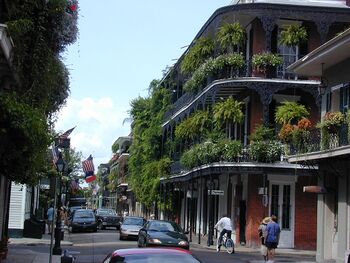New Orleans
(City) | |
|---|---|
 | |
| Socio-Ethnically cleansed after 2005 Hurricane Katrina. |
New Orleans is a city located along the Mississippi River in the southeastern region of the U.S. state of Louisiana. With an estimated population of 390,144 in 2019,[1] it is the most populous city in Louisiana. Serving as a major port, New Orleans is considered an economic and commercial hub for the broader Gulf Coast region of the United States.
Founded in 1718 by French colonists, New Orleans was once the territorial capital of French Louisiana before being traded to the United States in the Louisiana Purchase of 1803. New Orleans in 1840 was the third-most populous city in the United States,[2] and it was the largest city in the American South from the Antebellum era until after World War II. The city has historically been very vulnerable to flooding, due to such factors as high rainfall, low lying elevation, poor natural drainage, and location next to multiple bodies of water. State and federal authorities have installed a complex system of levees and drainage pumps in an effort to protect the city.[3]
Ethnic Cleansing
New Orleans was severely affected by Hurricane Katrina in August 2005, which flooded more than 80% of the city, killed more than 1,800 people, and displaced thousands of residents, causing a population decline of over 50%.[4] Since Katrina, major redevelopment efforts have led to a rebound in the city's population. Concerns about gentrification, new residents buying property in formerly closely knit communities, and displacement of longtime residents have been expressed.[5]
Exposure
Naomi Klein wrote in The Shock Doctrine about "the attempt to exploit the disastrous flooding of New Orleans to close down that city's public housing project", terming it in 2007 it " one of the most shameless examples of disaster capitalism".[6]
Related Quotation
| Page | Quote | Author | Date |
|---|---|---|---|
| Interpen | “Interpen (Intercontinental Penetration Force) was established in 1961 by Gerry P. Hemming. Other members included Loran Hall, Roy Hargraves, William Seymour, Lawrence Howard, Steve Wilson, Howard K. Davis, Edwin Collins, James Arthur Lewis, Dennis Harber, Bill Dempsey, Dick Whatley, Ramigo Arce, Ronald Augustinovich, Joe Garman, Edmund Kolby, Ralph Schlafter, Manuel Aguilar and Oscar Del Pinto. A recently declassified document says that in 1962, Robert Emmett Johnson was a member of Interpen. Later that year Johnson invited Robert K. Brown (USAR/CounterIntelligence Corps) to a meeting in Miami. Brown was the publisher of Alberto Bayo's 100 Questions for a Guerrilla. This book included an article written by Ulius Amoss called Leaderless Resistance which "referred to the proper strategy for conducting resistance operations against Castro and inside/outside of Cuba". The document also goes onto say: "Also included were numerous fotos of the G/W instructor cadre of InterPen which were taken by Brown at the Everglades training camp." Interpen was also involved in training members of the anti-Castro groups funded by people like Roland Masferrer, Carlos Prio and Santos Trafficante. When the government began to crack down on raids from Florida in 1962, Interpen set up a new training camp in New Orleans. The group carried out a series of raids on Cuba in an attempt to undermine the government of Fidel Castro. These stories were reported by the photo-journalist, Tom Dunkin, for Life Magazine. Roy Hargraves working closely with Felipe Vidal Santiago, carried out a series of raids on Cuba in the 1960s (23 in 1962). This involved a plan to create a war by simulating an attack on Guantanamo Naval Base. In 1963 Hargraves led a team of exiles in a successful raid on Cuba. After capturing two Cuban fishing boats Hargraves took them to the Bahamas. Some members such as William Seymour and Edwin Collins, worked with Bernardo De Torres on non-Interpen operations in 1963. Declassified FBI files show that the agency had an informer within Interpen. His code name was MM T-1. In one document dated 16th June, 1961, it said that MM T-1 had “been connected with Cuban revolutionary activities for the past three years”. One document dated 12th May, 1961, claims that Allen Lushane of Miami “had made a trip to Texas to recruit Americans for some future military action against the Government of Cuba”. The document adds that the “first training camp was established by Gerald Patrick Hemming with Dick Watley and Ed Colby running the camp.” In an interview that he gave to John M. Newman on 6th January, 1995, Hemming claims that the FBI informer was Steve Wilson. Some researchers believe that a combination of Interpen members, CIA agents and anti-Castro Cubans were involved in the assassination of John F. Kennedy. This included James Arthur Lewis, Roy Hargraves, Edwin Collins, Steve Wilson, Gerry P. Hemming, David Morales, Herminio Diaz Garcia, Tony Cuesta, Eugenio Martinez, Virgilio Gonzalez, Felipe Vidal Santiago, Robert Emmett Johnson, Carl E. Jenkins, Chi Chi Quintero and William Robertson.<a href="#cite_note-1">[1]</a>” | John Simkin | 20 May 2015 |
Event
| Event | Description |
|---|---|
| Hurricane Katrina | Hurricane which caused over 1,800 deaths and $125 billion in damage in late August 2005. The most damage was suffered in New Orleans, Louisiana. |
References
- ↑ https://www.census.gov/quickfacts/fact/table/neworleanscitylouisiana
- ↑ https://www.census.gov/population/www/documentation/twps0027/tab07.txt
- ↑ https://web.archive.org/web/20180625161834/http://orleanslevee.com/history.htm
- ↑ https://www.kff.org/other/poll-finding/report-new-orleans-three-years-after-the/
- ↑ https://www.buzzfeed.com/johnstanton/is-post-katrina-gentrification-saving-new-orleans-or-destroy
- ↑ https://tsd.naomiklein.org/articles/2007/12/shock-doctrine-action-new-orleans.html